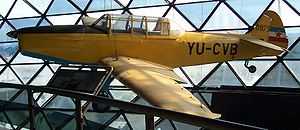Ikarus Aero 2
| Aero 2 | |
|---|---|
 | |
| Role | Primary trainer |
| National origin | Yugoslavia |
| Manufacturer | Ikarus |
| First flight | 1940 |
| Introduction | 1948 |
| Retired | 1959 |
| Primary user | Yugoslav Air Force |
| Number built | 248 |
|
| |
The Ikarus Aero 2 was a piston-engined military trainer aircraft built in Yugoslavia in the years following World War II, although the design pre-dated the war.
Design and development
The Ikarus Aero-2 was developed as a replacement for the Zmaj Fizir FN, which had been the most commonly used training aircraft of the Yugoslav Royal Air Force up until 1941. The Ikarus Aero-2 was designed by Boris Cijan and Đorđe Petković. Also at same time, was started project on two different aircraft, low-wing Ikarus MM-2 for advanced train and low-wing Rogožarski Brucoš for basic train. First flight test was made in April 20, 1940 and test pilot was Vasilije Stojanovic. 248 plane were eventually built, serving from 1948 to 1959 (380 built according to.[1] Powerplant was to be the de Havilland Gipsy Major because of its successful use in similar trainer aircraft built in other countries. The Aero 2 was a low-wing monoplane that seated the student and instructor in tandem, open cockpits (although later versions added a canopy to enclose them). Undercarriage was fixed and used a tailskid.
Variants
- Aero 2B
- Open cockpit version with a 145hp (108kW) de Havilland Gipsy Major engine.
- Aero 2BE
- Enclosed cockpit version with a 145hp (108kW) de Havilland Gipsy Major engine.
- Aero 2C
- Open cockpit version with a 160hp (119kW) Walter Minor 6-III engine.
- Aero 2D
- Enclosed cockpit version with a 160hp (119kW) Walter Minor 6-III engine.
- Aero 2E
- Enclosed cockpot version with a 160hp (119kW) Walter Minor 6-III engine.
- Aero 2F
- Open cockpit version with a 160hp (119kW) Walter Minor 6-III engine.
- Aero 2H
- Twin-float version with a 160hp (119kW) Walter Minor 6-III engine.
Operators
- Yugoslavian Air Force
- 1st Training Aviation Regiment (1945–1948)
- 3rd Training Aviation Regiment (1946-1948)
- 103rd Reconnaissance Aviation Regiment (1949–1951)
- 105th Training Aviation Regiment (1948-1949, 1951-1959)
- 267th Aviation Regiment of School of Reserve Officers (1951–1953)
- 122nd Hydroplane Liaison Squadron (1949–1959)
- Training Squadron of 29th Aviation Division (1953–1961)
- Training Squadron of 39th Aviation Division (1956–1959)
- Training Squadron of 44th Aviation Division (1956–1961)
- Liaison Squadron of 7th Aviation Corps (1953–1956)
Specifications (2B)
Data from The Illustrated Encyclopedia of Aircraft[2]
General characteristics
- Crew: 1
- Capacity: 1
- Length: 8.45 m (27 ft 8¾ in)
- Wingspan: 10.5 m (34 ft 5¼ in)
- Height: 2.80 m (8 ft 10¼ in)
- Wing area: 17.4 m2 (187 ft2)
- Empty weight: 564 kg (1241 lb)
- Gross weight: 996 kg (2196 lb)
- Powerplant: 1 × de Havilland Gipsy Major, 108 kW (145 hp)
Performance
- Maximum speed: 208 km/h (129 mph)
- Range: 680 km (423 miles)
- Service ceiling: 4500 m (14,765 ft)
See also
- Aircraft of comparable role, configuration and era
- Miles Magister
- RWD-23
References
Notes
- ↑ Ugolok Neba
- ↑ Orbis 1985, page 36
Bibliography
- The Illustrated Encyclopedia of Aircraft (Part Work 1982-1985). Orbis Publishing.
External links
| ||||||||||||||
| ||||||||||||||||||||||